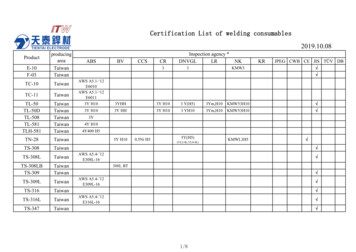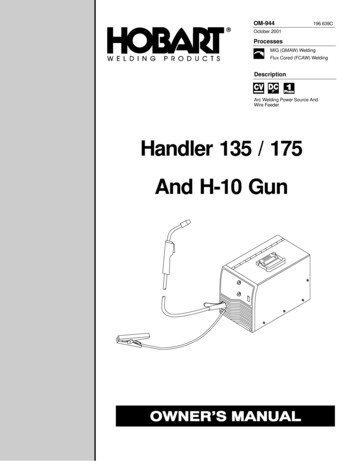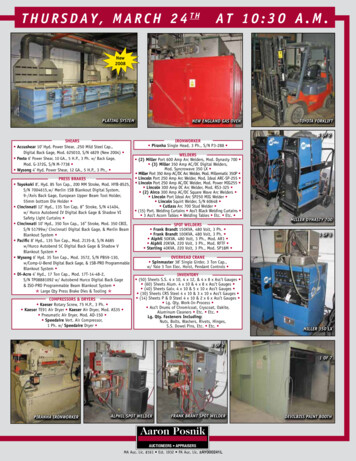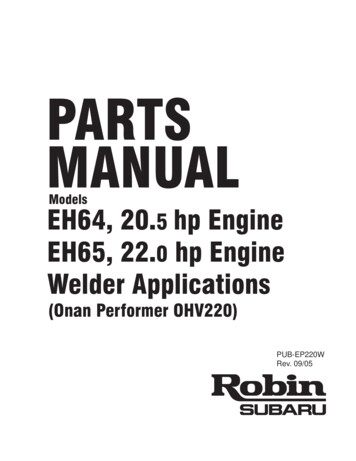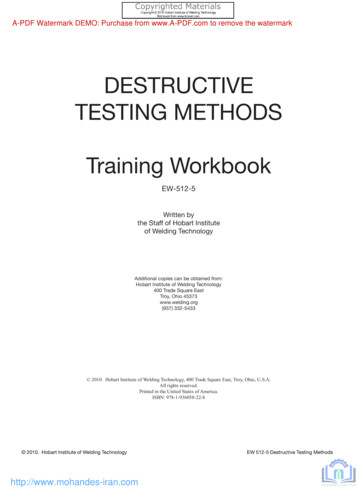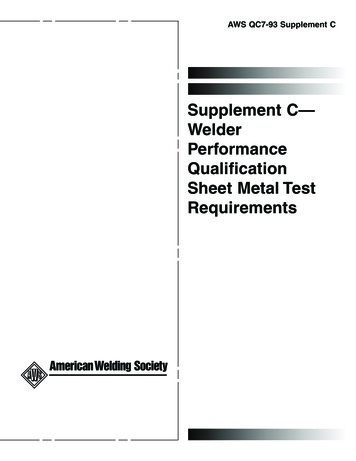
Transcription
EW607TECHNICALGUIDESafety & Health of WeldersCovers hazards related to electric shock, arc radiation, air contamination,fire & explosion, compressed gases, weld cleaning, and more.
Safety andHealth ofWeldersWritten bythe Staff of Hobart Instituteof Welding TechnologyEdited byAugust F. ManzThe Hobart Institute of Welding Technology presents thisinformation as a guideline for good safety and healthpractices. It is information available at the time of production of this publication. Relevant standards may have beenupdated and should be reviewed together with this bookfor accuracy. It is not intended to be the only source ofarc welding safety information. Federal or other laws andstandards may govern different operations and facilities.Additional sources for arc welding safety are given in thereferences.This document should be read and understood by allpersons involved with welding and cutting. This includeswelders, supervisors, management, contractors, educators, and others.Additional copies can be obtained from:Hobart Institute of Welding Technology400 Trade Square EastTroy, Ohio 45373www.welding.org(937) 332-5433Hobart Institute of Welding Technology disclaims liability for any injury to personsor to property, or other damages of any nature whatsoever, whether special, indirect,consequential or compensatory, directly or indirectly resulting from the publication,use of, or reliance on this book. Hobart Institute of Welding Technology makes noguaranty or warranty as to the accuracy or completeness of any information publishedherein. 2009. Hobart Institute of Welding Techology, 400 Trade Square East, Troy, Ohio, U.S.A.All rights reserved.Printed in the United States of America.978-1-936058-19-8
Table of Contents1. Personal Protection and Safety Rules . Page 1Welding Workplace SafetyMaterial Safety Data SheetsHeat ExposureProtective ClothingSafety RulesSafety Precautions for Arc WeldingSafety Precautions for Oxyacetylene Welding & Cutting2. Electric Shock Hazard . Page 8InstallationUseMaintenance3. Arc Radiation Hazard . Page 9Eye ProtectionContact LensesTransparent Welding CurtainsOther Factors4. Air Contamination Hazard. Page 12Particulate MatterGasesConfined or Enclosed AreasVentilation5. Fire & Explosion Hazard . Page 17Work AreaFuel GasesApparatusHot Work PermitsWelding on ContainersHot Tapping6. Compressed Gases . Page 19Treatment of Gas CylindersCylinder StorageOxygenFuel GasesShielding Gases7. Weld Cleaning & Other Hazards . Page 20Radioactive Hot AreasNoiseOther Hazards8. Safety for Specific Welding Processes and Occupations . Page 21Underwater WeldingRobotic and Automated WeldingBrazing & SolderingResistance WeldingArc Air CuttingElectron Beam WeldingThermal SprayingLaser WeldingAlllied Processes9. References . Page 2210. Web Sites . Page 23iii
6.17.18.19.20.21.Precautionary Information for Arc Processes and EquipmentPage 1 of Typical Material Safety Data SheetPage 2 of Typical Material Safety Data SheetPage 3 of Typical Material Safety Data SheetWelder Dressed for Light Duty WeldingWelder Dressed for Heavy Duty WeldingPrecautionary Information for Oxyfuel Gas ProcessesInsulating Devices on Terminals of a Welding MachineWelding HelmetEye Protection Filter Shade SelectorWelding Station Using Transparent Welding ScreenPrecautionary Information for Fluxes That Contain FluoridesPrecautionary Information for Brazing Filler Metals ContainingCadmium.Welding Booths With Mechanical VentilationLocal Exhaust Ventilation Using Movable HoodLocal Exhaust Ventilation Using Welding Gun Exhaust NozzleLocal Exhaust Ventilation Comparison With and Without ExhaustLocal Exhaust Ventilation Using Movable Hood DesignHot Work PermitSafe Way To Weld Containers That Held CombustiblesWorker Wearing Suitable Ear Protection for Noisy Workiv
WARNING:1. Personal Protection andSafety RulesPROTECT yourself and others. Read and understand this information.FUMES AND GASES can be hazardous to your health.ARC RAYS can injure eyes and burn skin.Your safety and health is extremely important. All workers engaged in production and construction are continually exposed topotential hazards. There are a number of potential safety and healthproblems associated with welding, cutting, and allied processes.When correct precautionary measures are followed, welding is asafe occupation. Health officials state that welding, as an occupation, is no more hazardous or injurious to the health than othermetal working occupations.(l)ELECTRIC SHOCK can KILL. Before use, read and understand the manufacturer’s instructions, Material Safety DataSheets (MSDSs) and your employer’s safety practices. Keep your head out of the fumes. Use enough ventilation, exhaust at the arc, or both, to keep fumes and gases fromyour breathing zone and the general area. Wear correct eye, ear, and body protection. Do not touch live electrical parts.Governments have become increasingly active concerning thesafety and health of workers and have enacted laws prescribingsafety regulations and the publication of safety information toinsure the safety of workers. In the United States, the provisionsof the Occupational Safety and Health Act (OSHA)(2) are the law. Itmakes many national consensus standards enforceable. The mostimportant welding standard is the American National Standard“ANSI Z49.1, Safety in Welding,Cutting, and Allied Processes”.(3)This standard states that welding and cutting operations posepotential hazards from fumes, gases, electric shock, heat radiation, and sometimes noise. All personnel shall be warned againstthese hazards where applicable by the use of adequate precautionary labeling. The minimum precautionary label for arc weldingprocesses and equipment, which is recommended, is shown inFigure 1. There are other hazards which apply to all metal workingoccupations. These are accidents resulting from falling, being hitby moving objects, working around moving machinery, exposureto hot metal, etc. Normal precautions are required with regard tothese hazards as well. Hazards that relate to welding are:Electrical shockArc radiationCompressed gasesWelding cleaningAir contaminationFire and explosionOther hazards related tospecific occupations See American national Standard ANSI Z49.1: Safety in Welding, Cutting, and AlliedProcesses, published by the American Welding Society, 550 N. W. LeJeune Road,Miami, FL 33126; OSHA Safety and Health Standards are published by the U.S.Government Printing Office, 732 North Capitol Street NW, Washington, DC 20401.DO NOT REMOVE THIS INFORMATIONFigure 1 - Precautionary Information for Arc WeldingProcesses and Equipmentsuch as the proper fire extinguishers, life saving and supportequipment, first aid kits, and so on. Train personnel to utilize thisequipment properly. Only approved equipment should be used andit must be properly installed and maintained in good working order.Material Safety Data Sheets (MSDSs)OSHA requires that employers must have a comprehensive hazard communication program to inform employees about hazardoussubstances that might be used in the workplace. The purpose ofthe MSDSs is to explain the hazards involved in handling/usingproducts such as welding consumables and the precautionarymeasures which must be put in place for safe welding. The employer must maintain continuous training concerning such materials, and safety in general. Provisions to safeguard employees areincluded in Material Safety Data Sheets (MSDSs) as prescribedby the Hazard Communication Standard of the U.S. Departmentof Labor.(5) Information must be provided for all substances takeninto the workplace except foods, drugs, cosmetics or tobaccoproducts used for personal consumption. The use of these datasheets in all manufacturing workplaces has been mandated since1985. Employees must be trained on the information in MaterialSafety Data Sheets and labels.Welders work under a variety of conditions including outdoors,indoors, in open areas, in confined spaces, high above the ground,and even under water. They utilize a large number of welding andcutting processes, however most of these have in common theexposure to fumes, gases, radiation and heat. Welders may beexposed to a number of factors simultaneously. The use of specificwelding processes or welding on particular metals can presentpotential health risks, which will be covered later. Additional information is available in the American Welding Society publicationslisted in the references section of this book.Each Material Safety Data Sheet for welding products includesinformation about every hazardous component comprising 1% ormore of the contents, and for every potential carcinogen (cancerinciting or producing) comprising 0.1% or more. Many of the components are included in the listing by the American Conference ofGovernmental Industrial Hygienists with threshold limit values.(6)Welding Workplace SafetyThe welding management and supervisors are responsible forassuring the workers are trained in the safe conduct of their dayto day activities. Employees must be informed and trained sothat they are able to detect when hazards are present and protectthemselves from them.Material Safety Data Sheets are required to be provided automatically by the suppliers of welding electrodes, fluxes, andgases. They should be kept on file in the personnel or weldingdepartments and be readily available in the workplace. The trainingprogram must cover not only welders, but others working in thewelding area such as service personnel, maintenance personnel,regular visitors to the welding shop, and others. A typical materialsafety data sheet for a tubular arc welding electrode is shown inFigures 2, 3, and 4. Particular points of interest are highlighted toprovide more data for intelligent interpretation of this information.(7)Hazardous communication programs and welding safety trainingprograms must be ongoing.The welders and other employees have an obligation to learnand use safe practices and to obey safety rules and regulations.They are responsible for the proper use of equipment. They havean obligation to learn safe practices, to obey safety rules andregulations and are expected to work in a safe manner. It is theresponsibility of supervisors to assure safety rules and regulationsare followed.Combustible materials must not be allowed to collect in or nearthe welding workplace. Good housekeeping practices shouldalways be employed. Adequate safety devices should be provided1
MSDS NO: TR-TWREVISED: (date)TW 2885MATERIAL SAFETY DATA SHEETFor U.S. Manufactured or Distributed Welding Consumables and Related Products. May be used to comply with OSHA’s Hazard Communication Standard,29 CFR 1910. 1200 and Superfund Amendments and Reauthorization Act (SARA) of 1986 Public Law 99-499. Standard must be consulted for specific requirements.Hazards inthe fillermetal orflux itselfChemicalAbstractsService No.(safety information,immediately availableby telephone tophysiciansand paramedics).PEL PermissibleExposureLimit, mg/m3.AmericanConferenceof GovernmentalIndustrialHygienistsThreshhold LimitValue (mg/m3). Timeweightedaverage.SECTION 1 – IDENTIFICATIONManufacturer/Supplier Name:ABC COMPANYAddress:MAIN STREET, ANY CITY, ZIPCODE, USATelephone No: (000) 000-0000Emergency No: (000) 000-0000Products For: TUBULAR ARC WELDING ELECTRODES FOR FLUX CORED, METAL CORED AND COMPOSITE SUBMERGED ARC WELDING “GROUP A”: ProductType: Gas Shielded Carbon and Low Alloy Steel“GROUP B”: Product Type: Self-Shielded Carbon Steel“GROUP C”: Product Type: Carbon and Low Alloy Steel “GROUP D”: Product Type: Corrosion Resisting Steel Metal CoredSECTION 2 - HAZARDOUS INGREDIENTSIMPORTANT - This section covers the hazardous materials from which this product is manufactured. The fumes and gases produced during weldingwith normal use of this product are also addressed in Section 5. The term “hazardous” in this section should be interpreted as a term required anddefined in OSHA Hazard Communication Standard (29 CFR Part 1910.1200).HAZARDOUS%INGREDIENTSIRON IRON OXIDEMANGANESE#WEIGHTGroup A Group B75-9875-95—— 4.5 2TITANIUM DIOXIDESILICON FLUORSPARMOLYBDENUM 10 4 5(5) 1 4(4) 2(4)1-10—CALCIUM CARBONATE 2ALUMINUM###Group C75-95 2 4Group D75-95— 2CAS NO.7439-89-61309-37-17439-96-5 10 4 5 2 2 2— 213463-67-77440-21-37789-75-57439-98-7 2(7)——1317-65-3 2 5(6) 3(6)—7429-90-5MAGNESIUM MAGNESIUM OXIDEBARIUM FLOURIDE#NICKEL#———— 3 35-15(1)———5-15(3) 4——— — 35 - 207440-47-3COPPER# 1(2)— 2(2)—7440-50-8TITANIUM SILICA (Amorphous Silica Fume)LITHIUM FLUORIDESTRONTIUM FLUORIDECOBALTCERIUM OXIDE— 2—— 2 2 2—————- 2(9) 2(8)——- 2(9)— 1(10) -24-47783-48-47440-48-41306-38-3EXPOSURE LIMIT (mg/m3)OSHA PELACGIH TLV5 R*3 R*10 (Oxide Fume)5 R*(Oxide {A4}5 CL** (Fume)0.21, 3 STEL*** (Fume)(As inorganic Compounds of Mn)15 (Dust)10 {A4}5 R*3 R* u u u2.5 (as F)2.5 (as F) {A4}5 R*3 R*; 10 I*(Elemental and Insoluble)0.5 R*(Soluble Compounds) {A3}5 R*10 u u u u u5 (as CaO)2 (as CaO)5 R* (Dust)10 (Dust)2 (soluble salts, as Al)5 R*3 R*15 (Fume, total particulate)10 I* {A4}0.5 (as Ba)0.5 (as Ba) {A4}1 (Metal)1.5 I* (Elemental) {A5}1 (Soluble Compounds)0.1 I* (Soluble Compounds) {A4}1 (Insoluble Compounds)0.2 I* (Insoluble Compounds){A1}1 (Metal)0.5 (Metal) {A4}0.5 (Cr II & Cr III Compounds)0.5 (Cr III Compounds) {A4}0.005 (Cr VI Compounds)0.05 (Cr VI Soluble Compounds){A1}0.01 (Cr VI InsolubleCompounds) {A1}1 (Dust)1 (Dust and Mists)u, u u0.1 (Fume)0.2 (Fume)u, u u5 R*3 R*0.1 R*0.025 R* {A2}0.83 R* u u u2.5 (as F)2.5 (as F) {A4}2.5 (as F)2.5 (as F) {A4}0.1 (Dust&Fume)0.02 {A3}15 (Dust)10 (Dust)5 R* (Dust)3 R* (Dust)(1) Present only in Group B Product Types (2) Present only in Group A and Group C Product Types (3) Present only in Group C Product Types (4) Present only in Group BProduct Types (5) Present only in Group A Product Types (6) Present in All Group B Product Types (7) Present only in Group C Product Types (8) Present only in Group BProduct Types (9) Present only in Group C Product Types (10) Present only in Group C Product Types (11) Present only in Group C Product Types* - Respirable Fraction I* - Inhalable Fraction ** - Ceiling Limit *** - Short Term Exposure Limit. - As a nuisance particulate covered under “Particulates Not OtherwiseRegulated” by OSHA or “Particulates Not Otherwise Classified” by ACGIH. - Crystalline silica is bound within the product as it exists in the package. However, research indicatessilica is present in welding fume in the amorphous #- Reportable material under Section 313 of SARA. ### - Reportable material under Section 313 of SARA as dust or fume. {A1}- Confirmed Human Carcinogen per ACGIH {A2} - Suspected Human Carcinogen per ACGIH {A3} - Confirmed Animal Carcinogen with Unknown Relevance to Humans perACGIH {A4} - Not Classifiable as a Human Carcinogen per ACGIH {A5} - Not Suspected as a Human Carcinogen per ACGIH (noncrystalline) form. u - Listed under Notice ofIntended Changes in 2006 per ACGIH uu - Limit of 0.1 mg/m3 is proposed for Cu I* and 0.05 mg/m3 is proposed for Cu R* of soluble compounds in 2006 by ACGIH uuu - TLVwithdrawn in 2006 uuuuu - Intention to withdraw TLV in 2006 per ACGIHThe exposure limit for welding fume has been established at 5 mg/m3 with OSHA’s PEL and ACGIH’s TLV. The individual complex compounds within the fume may havelower exposure limits than the general welding fume PEL/TLV. An Industrial Hygienist, the OSHA Permissible Exposure Limits For Air Contaminants (29 CFR 1910.1000),and the ACGIH Threshold Limit Values should be consulted to determine the specific fume constituents present and their respective exposure limits.Figure 2 - Page 1 of 3 of Typical Material Safety Data Sheet2
SECTION 3 - PHYSICAL/CHEMICAL CHARACTERISTICSWelding consumables applicable to this sheet are solid and nonvolatile as shipped.SECTION 4 - FIRE AND EXPLOSION HAZARD DATAWelding consumables applicable to this sheet as shipped are nonreactive, nonflammable, nonexplosive and essentially nonhazardous until welded.Welding arcs and sparks can ignite combustibles and flammable products. See American National Standard Z49.1 referenced in Section 7.Hazards createdby the welding arcor torch.Typical fumes.GasesHow to sampleactual fumes.Note effects ofoverexposure.SECTION 5 - REACTIVITY DATA - HAZARDOUS DECOMPOSITION PRODUCTSWelding fumes and gases cannot be classified simply. The composition and quantity of both are dependent upon the metal being welded, the process,procedures and electrodes used. Most fume ingredients are present as complex oxides and compounds and not as pure metals.Other conditions which also influence the composition and quantity of the fumes and gases to which workers may be exposed include: coatingson the metal being welded (such as paint, plating or galvanizing), the number of welders and the volume of the work area, the quality and amountof ventilation, the position of the welder’s head with respect to the fume plume, as well as the presence of contaminants in the atmosphere (such aschlorinated hydrocarbon vapors from cleaning and degreasing activities).When the electrode is consumed, the fume and gas decomposition products generated are different in percent and form from the ingredients listed inSection 2. Decomposition products of normal operation include those originating from the volatilization, reaction or oxidation of the materials shownin Section 2, plus those from the base metal and coating, etc., as noted above.Reasonably expected constituents of the fume would include: Complex oxides of iron, manganese, silicon and titanium. Groups A and B may alsocontain calcium oxides. Groups A, B and C may have fluorides present. Groups A, C, and D may also contain molybdenum. Group B may alsocontain magnesium. Groups A, B, and C may also contain aluminum. Groups B and C may also contain barium. Groups A and C may also containcopper. Groups C and D may also contain chromium and nickel. Group B may also contain magnesium, lithium and strontium.Monitor for the materials identified in Section 2. Fumes from the use of this product may contain barium, fluorides, manganese, calciumoxide, chromium and nickel compounds, copper, and amorphous silica fume whose exposure limits are lower than the 5 mg/m3 PEL/TLV forgeneral welding fume.Gaseous reaction products may include carbon monoxide and carbon dioxide. Ozone and nitrogen oxides may be formed by the radiation from the arc.One recommended way to determine the composition and quantity of fumes and gases to which workers are exposed is to take an air sample insidethe welder’s helmet if worn or in the worker’s breathing zone. [See ANSI/AWS F1.1, available from the “American Welding Society”, P.O. Box351040, Miami, FL 33135. Also, from AWS is F1.3 “Evaluating Contaminants in the Welding Environment - A Sampling Strategy Guide”, whichgives additional advice on sampling.]SECTION 6 - HEALTH HAZARD DATAEFFECTS OF OVEREXPOSURE:Electric arc welding may create one or more of the following health hazards:ARC RAYS can injure eyes and burn skin.ELECTRIC SHOCK can kill. See Section 7.FUMES AND GASES can be dangerous to your health.PRIMARY ROUTES OF ENTRY are the respiratory system, eyes and/or skin.SHORT-TERM (ACUTE) OVEREXPOSURE EFFECTS:WELDING FUMES - May result in discomfort such as dizziness, nausea or dryness or irritation of nose, throat or eyes.IRON, IRON OXIDE - None are known. Treat as nuisance dust or fume.MANGANESE - Metal fume fever characterized by chills, fever, upset stomach, vomiting, irritation of the throat and aching of body. Recovery isgenerally complete within 48 hours of the overexposure.TITANIUM DIOXIDE - Irritation of respiratory system.SILICA (AMORPHOUS) - Dust and fumes may cause irritation of the respiratory system, skin and eyes.FLUORIDES - Fluoride compounds evolved may cause skin and eye burns, pulmonary edema and bronchitis.MOLYBDENUM, CERIUM OXIDE - Irritation of the eyes, nose and throat.CALCIUM OXIDE - Dust or fumes may cause irritation of the respiratory system, skin and eyes.ALUMINUM OXIDE - Irritation of the respiratory system.MAGNESIUM, MAGNESIUM OXIDE - Overexposure to the oxide may cause metal fume fever characterized by metallic taste, tightness of chestand fever. Symptoms may last 24 to 48 hours following overexposure.BARIUM - Aching eyes, rhinitis, frontal headache, wheezing, laryngeal spasms, salivation or anorexia.NICKEL, NICKEL COMPOUNDS - Metallic taste, nausea, tightness in chest, metal fume fever, allergic reaction.CHROMIUM - Inhalation of fume with chromium (VI) compounds can cause irritation of the respiratory tract, lung damage and asthma-like symptoms.Swallowing chromium (VI) salts can cause severe injury or death. Dust on skin can form ulcers. Eyes may be burned by chromium (VI) compounds.Allergic reactions may occur in some people.COPPER - Metal fume fever characterized by metallic taste, tightness of chest and fever. Symptoms may last 24 to 48 hours following overexposure.STRONTIUM COMPOUNDS - Strontium salts are generally non-toxic and are normally present in the human body. In large oral doses, they maycause gastrointestinal disorders, vomiting and diarrhea.LITHIUM COMPOUNDS - Overexposure may cause tremor and nausea.COBALT – Pulmonary irritation, cough, dermatitis, weight loss.LONG-TERM (CHRONIC) OVEREXPOSURE EFFECTS:WELDING FUMES - Excess levels may cause bronchial asthma, lung fibrosis, pneumoconiosis or “siderosis.”IRON, IRON OXIDE FUMES - Can cause siderosis (deposits of iron in lungs) which some researchers believe may affect pulmonary function. Lungswill clear in time when exposure to iron and its compounds ceases. Iron and magnetite (Fe3O4) are not regarded as fibrogenic materials.MANGANESE - Long-term overexposure to manganese compounds may affect the central nervous system. Symptoms may be similar to Parkinson’sDisease and can include slowness, changes in handwriting, gait impairment, muscle spasms and cramps and less commonly, tremor and behavioralchanges. Employees who are overexposed to manganese compounds should be seen by a physician for early detection of neurologic problems.TITANIUM DIOXIDE - Pulmonary irritation and slight fibrosis.SILICA (AMORPHOUS) - Research indicates that silica is present in welding fume in the amorphous form. Long term overexposure may causepneumoconiosis. Noncrystalline forms of silica (amorphous silica) are considered to have little fibrotic potential.FLUORIDES - Serious bone erosion (Osteoporosis) and mottling of teeth.MOLYBDENUM - Prolonged overexposure may result in loss of appetite, weight loss, loss of muscle coordination, difficulty in breathing and anemia.CALCIUM OXIDE - Prolonged overexposure may cause ulceration of the skin and perforation of the nasal septum, dermatitis and pneumonia.Figure 3 - Page 2 of 3 of Typical Material Safety Data Sheet (see previous page)3
Apply First Aid.Beware! Carcinogenic means it mayproduce cancer.Ventilate weldarea.Use respiratorwhen necessary.Wear helmet, filterlens.Protect from radiation, sparks electricshock, hot metal,sharp edges, pinchpoints, falls.Never exceed permissible exposurelimits.Protect yourself.The manufacturerdisclaims any responsibility.ALUMINUM OXIDE - Pulmonary fibrosis and emphysema.MAGNESIUM, MAGNESIUM OXIDE - No adverse long term health effects have been reported in the literature.BARIUM - Long term overexposure to soluble barium compounds may cause nervous disorders and may have deleterious effects on the heart,circulatory system and musculature.NICKEL, NICKEL COMPOUNDS - Lung fibrosis or pneumoconiosis. Studies of nickel refinery workers indicated a higher incidence of lungand nasal cancers.CHROMIUM - Ulceration and perforation of nasal septum. Respiratory irritation may occur with symptoms resembling asthma. Studieshave shown that chromate production workers exposed to hexavalent chromium compounds have an excess of lung cancers. Chromium (VI)compounds are more readily absorbed through the skin than chromium (III) compounds. Good practice requires the reduction of employeeexposure to chromium (III) and (VI) compounds.COPPER - Copper poisoning has been reported in the literature from exposure to high levels of copper. Liver damage can occur due to copperaccumulating in the liver characterized by cell destruction and cirrhosis. High levels of copper may cause anemia and jaundice. High levels ofcopper may cause central nervous system damage characterized by nerve fiber separation and cerebral degeneration.STRONTIUM COMPOUNDS - Strontium at high doses is known to concentrate in bone. Major signs of chronic toxicity, which involve theskeleton, have been labeled as “strontium rickets”.LITHIUM COMPOUNDS - May be considered as potentially teratogenic.COBALT – Repeated overexposure to cobalt compounds can produce reduced pulmonary function, diffuse nodular fibrosis of lungs and respiratoryhypersensitivity. IARC considers cobalt compounds as possibly carcinogenic to humans (GROUP 2B).MEDICAL CONDITIONS AGGRAVATED BY EXPOSURE:Persons with pre-existing impaired lung functions (asthma-like conditions).EMERGENCY AND FIRST AID PROCEDURES:Call for medical aid. Employ first aid techniques recommended by the American Red Cross.Eyes & Skin: If irritation or flash burns develop after exposure, consult a physician.CARCINOGENICITY:Chromium VI and nickel compounds must be considered as carcinogens under OSHA (29 CFR 1910.1200). Chromium VI compounds areclassified as IARC Group 1 and NTP Group 1 carcinogens. Nickel compounds are classified as IARC Group 1 and NTP Group 2 carcinogens.Welding fumes must be considered as possible carcinogens under OSHA (29 CFR 1910.1200).CALIFORNIA PROPOSITION 65:For Group C and D products: WARNING: This product contains or produces a chemical known to the State of California to cause cancer andbirth defects (or other reproductive harm). (California Health & Safety Code Section 25249.5 et seq.)For Group A and B products: WARNING: This product, when used for welding or cutting, produces fumes or gases which contain chemicalsknown to the State of California to cause birth defects and, in some cases, cancer. (California Health & Safety Code Section 25249.5 et seq.)SECTION 7 - PRECAUTIONS FOR SAFE HANDLING & USE/APPLICABLE CONTROL MEASURESRead and understand the manufacturer’s instructions and the precautionary label on the product. See American National Standard Z49.1; Safetyin Welding and Cutting published by the American Welding Society, P.O. Box 351040, Miami, FL 33135 and OSHA Publication 2206 (29 CFR1910), U.S. Government Printing Office, Washington, DC 20402 for more detail on any of the following.VENTILATION: Use enough ventilation, local exhaust at the arc or both to keep the fumes and gases below PEL/TLVs in the worker’s breathingzone and the general area. Train the welder to keep his head out of the fumes.RESPIRATORY PROTECTION: Use NIOSH approved or equivalent fume respirator or air supplied respirator when welding in confinedspace or where local exhaust or ventilation does not keep exposure below PEL/TLVs.EYE PROTECTION: Wear helmet or use face shield with filter lens. As a rule of thumb begin with Shade Number 14. Adjust if needed byselecting the next lighter and/or darker shade number. Provide protective screens and flash goggles, if necessary, to shield others.PROTECTIVE CLOTHING: Wear hand, head and body protection which help to prevent injury from radiation, sparks and electrical shock.See ANSI Z49.1. At a minimum this includes welder’s gloves and a protective face shield, and may include arm protectors, aprons, hats, shoulderprotection as well as dark nonsynthetic clothing. Train the welder not to touch live electrical parts and to insulate himself from work and ground.PROCEDURE FOR CLEANUP OF SPILLS OR LEAKS: Not applicableWASTE DISPOSAL: Prevent waste from contaminating surrounding environment. Discard any product, residue, disposable container or linerin an environmentally acceptable manner, in full compliance with Federal, State and Local regulations.SPECIAL PRECAUTIONS (IMPORTANT): Maintain exposure below the PEL/TLVs. Use industrial hygiene monitoring to ensure thatyour use of this material does not create exposures which exceed PEL/TLVs. Always use exhaust ventilation. Refer to the following sourcesfor important additional information: ANSI Z49.1 from the American Welding Society, P.O. Box 351040, Miami, FL 33135 and OSHA (29 CFR1910) from the U.S. Department of Labor, Washington, DC 20210.ABC Company believes this data to be accurate and to reflect qualified expert opinion regarding current research. However, ABC Companycannot make any expressed or implied warranty as to this information.Figure 4 - Page 3 of 3 of Typical Material Safety Data Sheet (see previous page)4
Heat Exposureas quickly. Cloth or soft leather gloves can be used for light-dutywork. For heavy-duty work, more thorough protective clothing isrequired. Figure 6 shows a welder dressed for heavy-duty weldingwork wearing leather gauntlet gloves, a leather cape, leather bib,and spats, which give additional protection against sparks andmolten metal. When welding in the vertical and overhead positionthis type of
welding processes or welding on particular metals can present potential health risks, which will be covered later. Additional infor-mation is available in the American Welding Society publications listed in the references section of this book. Welding Workplace Safety The weldin
